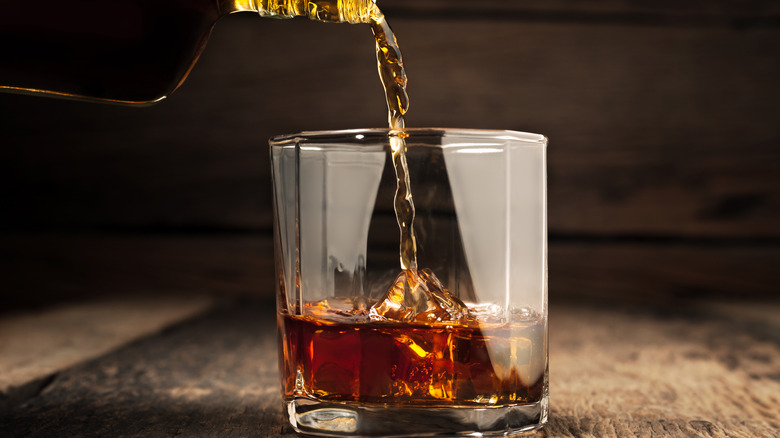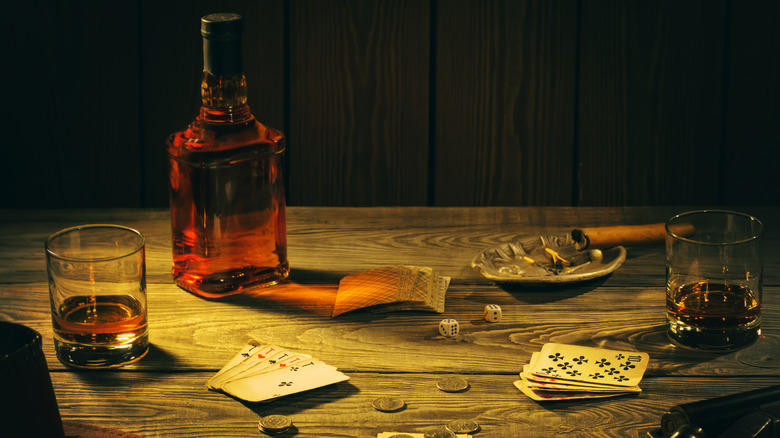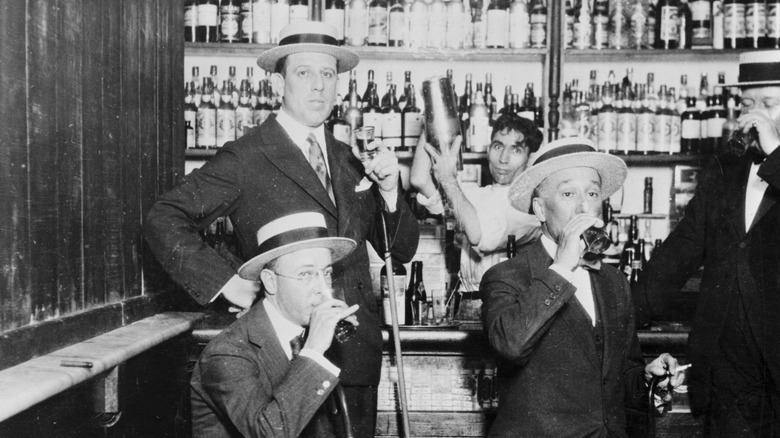What Rotgut Means For Whiskey And Why It Should Send You Running
There's an old cowboy drinking song that includes the stanza, "Whoop-ee! Drink that rot gut, drink that red nose / Whenever you get to town/ Drink it straight and swig it mighty/ Till the world goes round and round!" Imbibing in rotgut whiskey would indeed leave the world going round and round, if you were lucky. Or it could leave you dead. But what exactly is rotgut whiskey?
The term rotgut — meaning cheap, inferior, or adulterated alcohol – originally referred to beer. By the early 1800s, rotgut was in use in the U.S. when referring to bad whiskey. While the term often gets tossed around when discussing bottom shelf alcohol, a true rotgut whiskey wasn't actually whiskey. Instead, it was a mixture of a base alcohol and everything from chewing tobacco to cayenne pepper to give it the proper appearance and bite. In some cases, bootleggers used methanol as the base, which left many drinkers blind, brain damaged, and in some cases, dead, Gastrointestinal bleeding and liver and pancreas damage are just some of the issues resulting from methanol poisoning, according to the U.S. Centers for Disease Control (CDC).
The Old West was rife with rotgut
The term rotgut, when referring to alcohol, has a long history going back more than 400 years to its origins in England when it was specifically associated with bad beer. The term made the jump to America and by the mid-1800s was connected to whiskey, often bourbon. Like all whiskeys, bourbon is made from a combination of grains, yeast, and water, but it must include at least 51% corn and be aged in new charred oak barrels to earn the name. Back before the federal government regulated the liquor industry, especially in the frontier West, unscrupulous businesses claimed their products were bourbon, but they were in fact grain alcohol mixed with ingredients like creosote, strychnine, and even sulfuric acid.
The federal government finally began cracking down on these crooked companies around the turn of the 19th century through various new laws. But then Prohibition arrived in the U.S., banning the manufacture and sale of alcohol from 1920 to 1933. Soon, whiskey that was once merely considered cheap and unpalatable became downright deadly.
Prohibition helped make rotgut whiskey deadlier
While there were some cases of deadly rotgut whiskey before Prohibition, after the alcohol ban was put in place, bootleggers began making rotgut whiskey that included methanol, also known as wood alcohol, with deadly results. In 1926, 750 people died in New York City from wood alcohol-poisoning, with some estimating as many as 50,000 people perishing during Prohibition nationwide, and that doesn't include other victims who were paralyzed or suffered other injuries. While not all rotgut was deadly, it often tasted so bad that it gave rise to new drinks. Some of the cocktails we still enjoy today were invented during Prohibition to mask the taste of the inferior alcohol, including the Dubonnet cocktail, which combines the French fortified wine with gin.
Today, the term rotgut has come to mean any cheap alcohol. But not all cheap whiskey is considered rotgut. For instance, there are several bottom-shelf bourbons that are actually worth buying, including selections from Wild Turkey, Evan Williams, and Jim Beam. And then there's the American distillery that ironically named its whiskey "RotGut," which — at the price point and apparent care put into producing the liquor — is definitely tongue in cheek. Barring this, actual deadly rotgut whiskey isn't just an historical issue as there have been much more recent cases. In 2017, three people in China died of methanol-laced rotgut whiskey, and in 2024, over 50 people in India died of methanol-infused alcohol, so beware.


